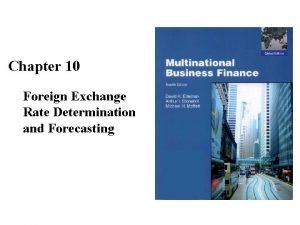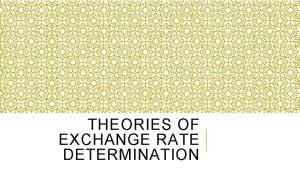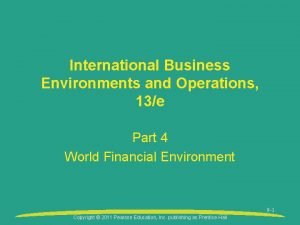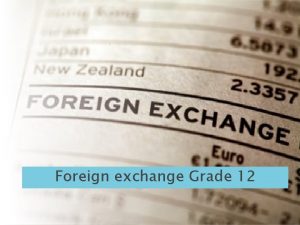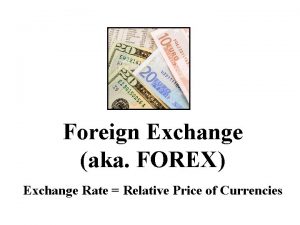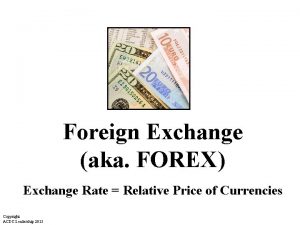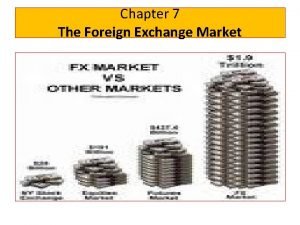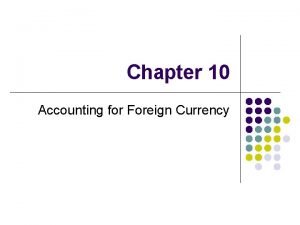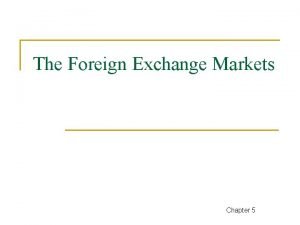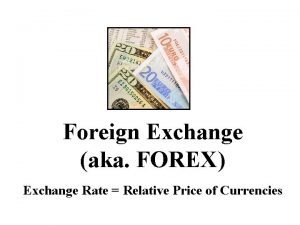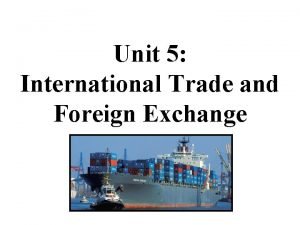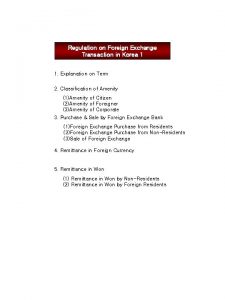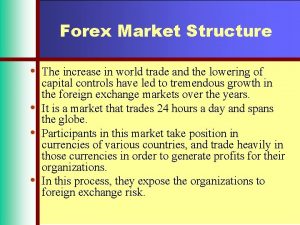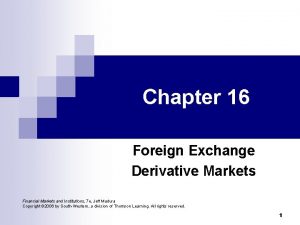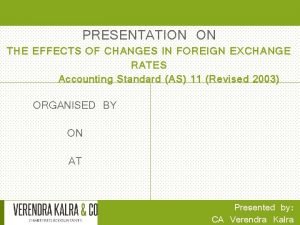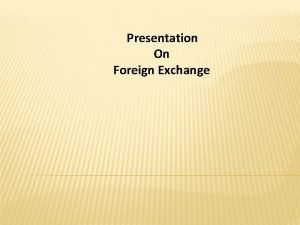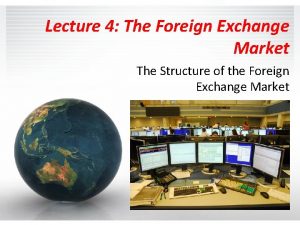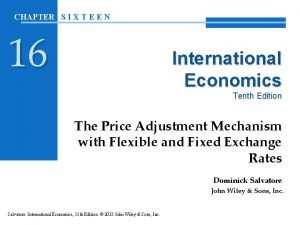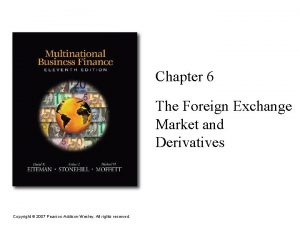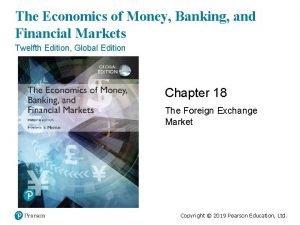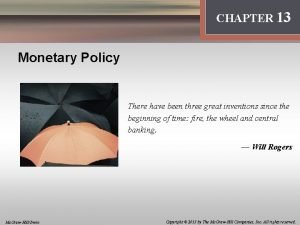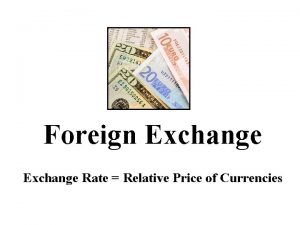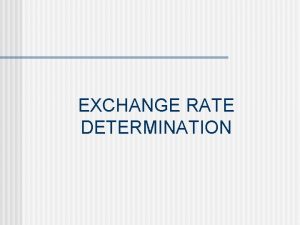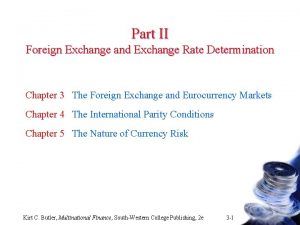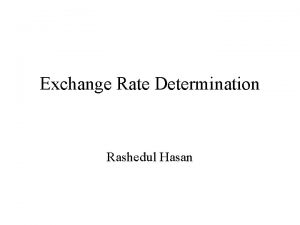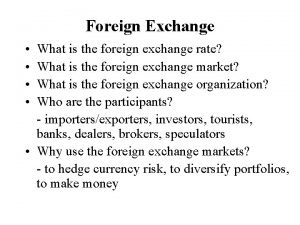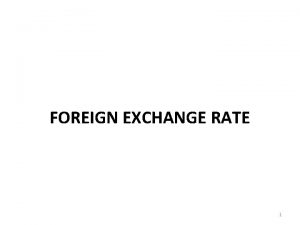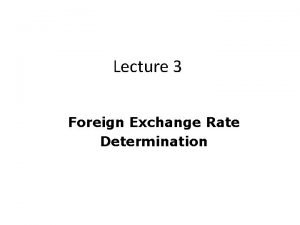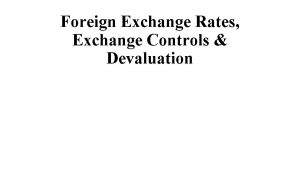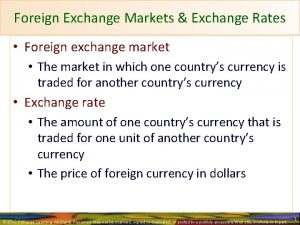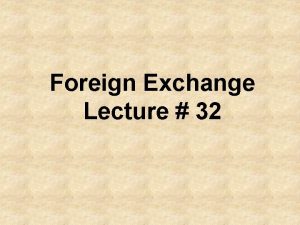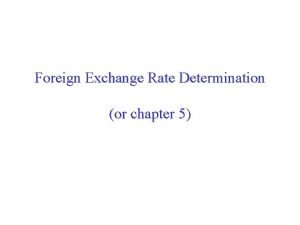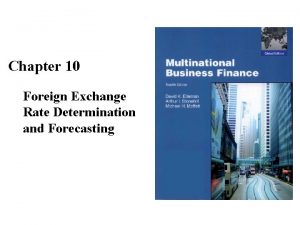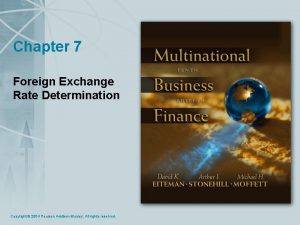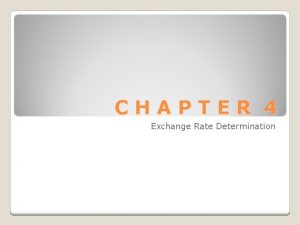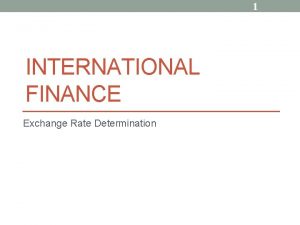Lecture 4 Foreign Exchange Rate Determination II Exchange




































- Slides: 36

Lecture 4 Foreign Exchange Rate Determination: II

Exchange Rate Determination: Theoretical Thread • The balance of payments approach is the second most utilized theoretical approach in exchange rate determination: – The basic approach argues that the equilibrium exchange rate is found when currency flows match up vis-à-vis current and financial account activities. – This framework has wide appeal as BOP transaction data is readily available and widely reported. – Critics may argue that this theory does not take into account stocks of money or financial assets.

The Balance of Payment Approach • • • According to this theory , exchange rate of a currency depends on its BOP position A favorable BOP raise the exchange rate And unfavorable BOP reduces the exchange rate Thus according to this theory exchange rate is determined by the demand supply of foreign exchange Demand foreign exchange arises from the debit side of the balance sheet Supply of foreign exchange arises from credit side of balance sheet 3

The Balance of Payment Approach • When BOP is unfavorable it means that demand foreign currency is more than its supply • It means that external value of domestic currency in relation to foreign currency fall • Consequently exchange rate to fall…. . how ? • Suppose RS 60=$1 , external value of domestic currency is. 017 • Due to unfavorable BOP Rs 90=$1 so external value of domestic currency is ………. 011 • On other hand if BOP is favorable it means that supply of foreign is greater than demand • It means that external value of domestic currency in relation to foreign currency rise 4

The Balance of Payment Approach • • Consequently exchange rate to rise Suppose RS 60=$1, so external value of domestic currency is. 017 Due to favorable BOP Rs 40=$1 so external value of domestic currency is ………. 025 In conclusion, in foreign exchange determination BOP is important 5

BOP Approach: Determination of exchange rate price of $ in Rupee S Exchange rate R 2 R R 1 S 0 D Q Dollars 6

Exchange Rate Determination: Theoretical Thread • The monetary approach in its simplest form states that the exchange rate is determined by the supply and demand for national monetary stocks, as well as the expected future levels and rates of growth of monetary stocks. • Other financial assets, such as bonds are not considered relevant for exchange rate determination, as both domestic and foreign bonds are viewed as perfect substitutes.

Exchange Rate Determination: Theoretical Thread • The asset market approach argues that exchange rates are determined by the supply and demand for a wide variety of financial assets: – Shifts in the supply and demand for financial assets alter exchange rates. – Changes in monetary and fiscal policy alter expected returns and perceived relative risks of financial assets, which in turn alter exchange rates.

Exchange Rate Determination: Theoretical Thread • The forecasting inadequacies of fundamental theories has led to the growth and popularity of technical analysis, the belief that the study of past price behavior provides insights into future price movements. • The primary assumption is that any market driven price (i. e. , exchange rates) follows trends.

The Asset Market Approach to Forecasting • The asset market approach assumes that whether foreigners are willing to hold claims in monetary form depends on an extensive set of investment considerations or drivers (among others): – Relative real interest rates – Prospects for economic growth – Capital market liquidity – A country’s economic and social infrastructure – Political safety – Corporate governance practices – Contagion (spread of a crisis within a region) – Speculation

The Asset Market Approach to Forecasting • Foreign investors are willing to hold securities and undertake foreign direct investment in highly developed countries based primarily on relative real interest rates and the outlook for economic growth and profitability. • The asset market approach is also applicable to emerging markets; however in these cases, a number of additional variables contribute to exchange rate determination (previous slide).

Currency Market Intervention (Why? ) • Foreign currency intervention is the active management, manipulation, or intervention in the market’s valuation of a country’s currency. • Why Intervene? – Fight inflation (strong currency) – Fight slow economic growth (weak currency)

Currency Market Intervention (How? ) • Methods of intervention are determined by magnitude of a country’s economy, magnitude of trading in it’s currency, and the country’s financial market development • Direct Intervention – the active buying and selling of the domestic currency against foreign currencies – If the goal is to increase the value, then the central bank buys its own currency – If the goal is to decrease the value, then the central bank sells its own currency

Currency Market Intervention (How? ) • If bank intervention is insufficient, then coordinated intervention may be used whereby several central banks agree on a strategy to increase or decrease a currency value. • Indirect Intervention – the alteration of economic or financial fundamentals which are thought to be drivers of capital to flow in and out of specific currencies – Increase real rates to strengthen a currency – Decrease real rates to weaken a currency

Currency Market Intervention (How? ) • Capital controls are restrictions of access to foreign currency by the government by limiting the exchange of domestic currency foreign currency. • Although intervention may fail, understanding the motivations and methods for currency market intervention is critical to any analysis of the determination of future exchange rates.

Exhibit 9. 2 Intervention and the Japanese Yen, 2010

Exhibit 9. 3 The History of Japanese Intervention

Disequilibrium: Exchange Rates in Emerging Markets • Although the three different schools of thought on exchange rate determination (parity conditions, balance of payments approach, asset approach) make understanding exchange rates appear to be straightforward, that it rarely the case. • The large and liquid capital and currency markets follow many of the principles outlined so far relatively well in the medium to long term. • The smaller and less liquid markets, however, frequently demonstrate behaviors that seemingly contradict theory. • The problem lies not in theory, but in the relevance of the assumptions underlying theory.

The Asian Crisis of 1997 • The roots of the Asian currency crisis extended from a fundamental change in the economics of the region, the transition of many Asian nations from being net exporters to net importers. • The most visible roots of the crisis were the excess capital inflows into Thailand in 1996 and early 1997. • As the investment “bubble” expanded, some market participants questioned the ability of the economy to repay the rising amount of debt and the Thai bhat came under attack.

The Asian Crisis of 1997 • The Thai government intervened directly (using up precious hard currency reserves) and indirectly by raising interest rates in support of the currency. • Soon thereafter, the Thai investment markets ground to a halt and the Thai central bank allowed the bhat to float. • The bhat fell dramatically (see Exhibit 9. 4) and soon other Asian currencies (Philippine peso, Malaysian ringgit and the Indonesian rupiah) came under speculative attack.

Exhibit 9. 4 The Thai Baht and the Asian Crisis

The Asian Crisis of 1997 • The Asian economic crisis (which was much more than just a currency collapse) had many roots besides traditional balance of payments difficulties: – Corporate socialism – Corporate governance – Banking liquidity and management • What started as a currency crisis became a region -wide recession.

The Argentine Crisis of 2002 • In 1991 the Argentine peso had been fixed to the U. S. dollar at a one-to-one rate of exchange. • A currency board structure was implemented in an effort to eliminate the source inflation that had devastated the nation’s standard of living in the past.

The Argentine Crisis of 2002 • By 2001, after three years of recession, three important problems with the Argentine economy became apparent: – The Argentine peso was overvalued – The currency board regime had eliminated monetary policy alternatives for macroeconomic policy – The Argentine government budget deficit – and deficit spending – was out of control

The Argentine Crisis of 2002 • In January 2002, the peso was devalued as a result of enormous social pressures resulting from deteriorating economic conditions and substantial runs on banks. • However, the economic pain continued and the banking system remained insolvent. • Social unrest continued as the economic and political systems within the country collapsed; certain government actions set the stage for a constitutional crisis. • Exhibit 9. 5 tracks the decline of the Argentine peso.

Exhibit 9. 5 The Collapse of the Argentine Peso

Forecasting in Practice • Technical analysts, traditionally referred to as chartists, focus on price and volume data to determine past trends that are expected to continue into the future. • The single most important element of technical analysis is that future exchange rates are based on the current exchange rate. • Exchange rate movements can be subdivided into three periods: – Day-to-day – Short-term (several days to several months) – Long-term

Forecasting in Practice • The longer the time horizon of the forecast, the more inaccurate the forecast is likely to be. • Whereas forecasting for the long run must depend on the economic fundamentals of exchange rate determination, many of the forecast needs of the firm are short to medium term in their time horizon and can be addressed with less theoretical approaches. • Exhibit 9. 6 summarizes the various forecasting periods, regimes, and the authors’ suggested methodologies.

Exhibit 9. 6 Exchange Rate Forecasting in Practice

Forecasting: What to Think? • It appears, from decades of theoretical and empirical studies, that exchange rates do adhere to the fundamental principles and theories previously outlined. • Fundamentals do apply in the long term • There is, therefore, something of a fundamental equilibrium path for a currency’s value.

Forecasting: What to Think? • It also seems that in the short term, a variety of random events, institutional frictions, and technical factors may cause currency values to deviate significantly from their long-term fundamental path. • This behavior is sometimes referred to as noise. • Therefore, we might expect deviations from the long-term path not only to occur, but to occur with some regularity and relative longevity. • Exhibit 9. 7 illustrates the synthesis of forecasting thought. • Exhibit 9. 8 shows the dynamics of exchange rate manipulation.

Exhibit 9. 7 Short-Term Noise Versus Long-Term Trends

Exhibit 9. 8 Exchange Rate Dynamics: Overshooting

Global Finance in Practice 9. 1 Technical Analysis of the JPY/USD Rate (January 2011– February 2014)

Global Finance in Practice 9. 3 The European Monetary System’s “Snake in a Tunnel”

Global Finance in Practice 9. 5 JPMorgan Chase Forecast of the Dollar/Euro
 Determination of exchange rate
Determination of exchange rate Exchange rate determination and forecasting
Exchange rate determination and forecasting So here you are too foreign for home
So here you are too foreign for home Exchange rate theories
Exchange rate theories 01:640:244 lecture notes - lecture 15: plat, idah, farad
01:640:244 lecture notes - lecture 15: plat, idah, farad Forex trading process
Forex trading process Foreign exchange tourism grade 12
Foreign exchange tourism grade 12 Foreign exchange shifters
Foreign exchange shifters Forex shifters
Forex shifters Functions of foreign exchange market
Functions of foreign exchange market Foreign exchange accounting
Foreign exchange accounting Objective of foreign exchange market
Objective of foreign exchange market Xlri foreign exchange program
Xlri foreign exchange program Foreign exchange shifters
Foreign exchange shifters Unit 5 international trade
Unit 5 international trade Foreign exchange transaction regulation korea
Foreign exchange transaction regulation korea Hsbc foreign exchange
Hsbc foreign exchange Fx market structure
Fx market structure Foreign exchange exposures
Foreign exchange exposures Foreign exchange luxembourg
Foreign exchange luxembourg Nominal effective exchange rate
Nominal effective exchange rate Foreign exchange derivative
Foreign exchange derivative Spot market in foreign exchange market
Spot market in foreign exchange market Examples of non integral foreign operations
Examples of non integral foreign operations Exchange rate presentation
Exchange rate presentation Exchange rates grade 11 maths literacy
Exchange rates grade 11 maths literacy Structure of foreign exchange market
Structure of foreign exchange market Foreign exchange market features
Foreign exchange market features Fema
Fema Stability of foreign exchange market
Stability of foreign exchange market Foreign exchange and international financial markets
Foreign exchange and international financial markets Foreign exchange market example
Foreign exchange market example Wise exchange program
Wise exchange program Foreign exchange market
Foreign exchange market Foreign exchange market graph
Foreign exchange market graph Exchange market graph
Exchange market graph Foreign exchange market
Foreign exchange market

